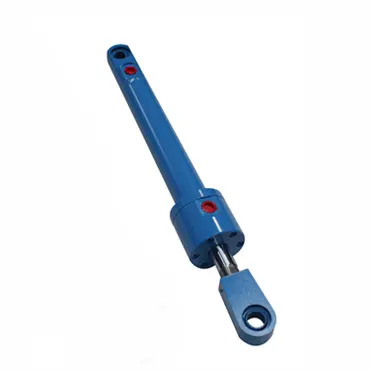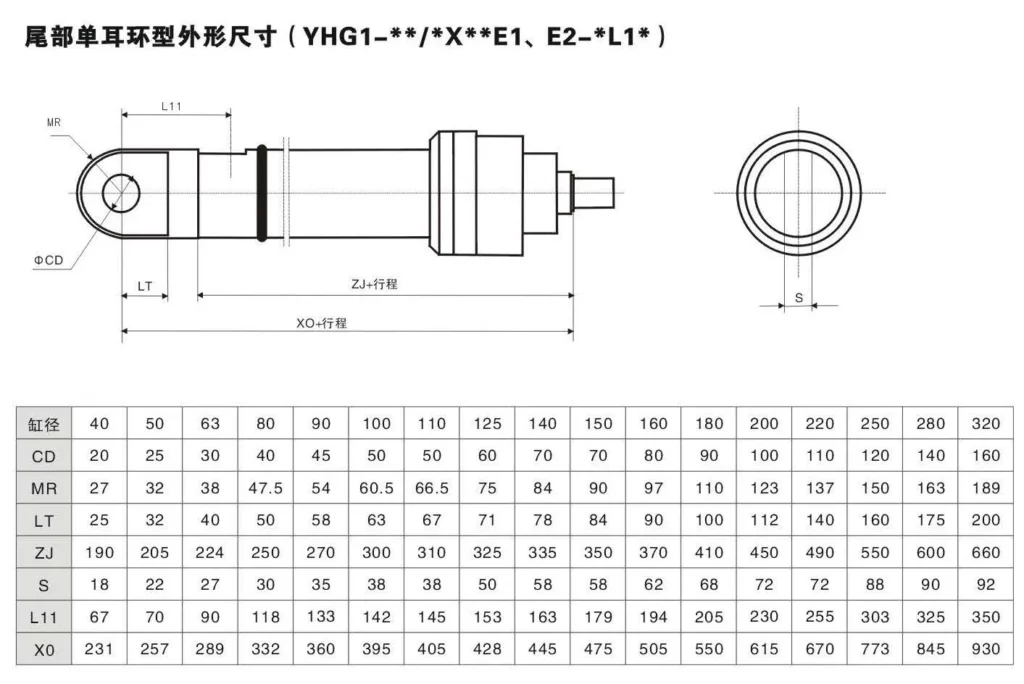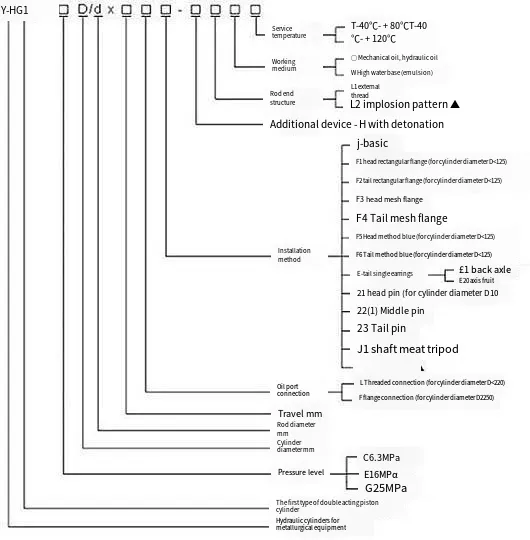Y-HG1 Metallurgical Hydraulic Cylinder
Y-HG1 Metallurgical Hydraulic Cylinder
Y-HG1 series metallurgical equipment hydraulic cylinder is a double-acting piston cylinder, and the cylinder diameter is generally in the range of 40~320mm, the working pressure <=16MPA, the hydraulic oil mechanical system can be used for milk transport and other working medium, installation flange, earrings, pins, release device (base) and different types.
High precision CNC honing machine, automatic welding machine, vertical, horizontal machining center, gantry machining center, CNC lathe, and other processing equipment, product quality is stable and guaranteed.

Metallurgical Hydraulic Cylinder Parameter:
(1)Axial Tripod Type Metallurgical Hydraulic Cylinder Parameter
(2)Head Method Orchid Type Metallurgical Hydraulic Cylinder
(3)Head Pin Type Metallurgical Hydraulic Cylinder
(4)Head Rectangular Flange Type Metallurgical Hydraulic Cylinder
(5)Head Round Flange Type Metallurgical Hydraulic Cylinder
(6) Middle Pin Type Metallurgical Hydraulic Cylinder
(7)Rear Method Orchid Type Metallurgical Hydraulic Cylinder
(8)Rear Pin Type Metallurgical Hydraulic Cylinder
(9)Rear Rectangular Flange Type Metallurgical Hydraulic Cylinder
(10)Rear Round Flange Type Metallurgical Hydraulic Cylinder

(11)Rear Single Earring Type Metallurgical Hydraulic Cylinder

(12) Y-HG1 Noraml Metallurgical Hydraulic Cylinder
Metallurgical Hydraulic Cylinder Technical Parameter:
Model example: Y-HG1-E40/22*50LJ1L10T1

冶金液压缸 Scope Of Application:
The hydraulic cylinder of Y-HG1 series metallurgical equipment is a double-acting piston cylinder. The cylinder diameter is generally in the range of 40~320mm, and the working pressure <=16MPA; its basic parameters include cylinder diameter, rod diameter, stroke, oil port size, and so on.
如何拆卸液压缸?
Taking apart a hydraulic cylinder requires careful disassembly to avoid damage and ensure safe handling. Here are the general steps to follow:
- Safety Precautions:
- Ensure the hydraulic system is depressurized and the cylinder is in a retracted position.
- Use appropriate personal protective equipment, such as gloves and safety glasses.
- Prepare a clean and organized workspace with adequate lighting and ventilation.
- Identify Cylinder Components:
- Familiarize yourself with the different parts of the hydraulic cylinder, including the cylinder body, piston, rod, seals, and end caps.
- Remove External Connections:
- Disconnect any hydraulic hoses, fittings, or other external connections attached to the cylinder.
- Use appropriate tools, such as wrenches or pliers, to loosen and remove the connections carefully.
- Secure the Cylinder:
- Place the cylinder securely in a vise or similar holding fixture, ensuring it is stable and won’t move during disassembly.
- Remove the Rod End Cap:
- Locate the rod end cap, which is typically situated at the end of the cylinder opposite the piston.
- Use the appropriate wrench or socket to loosen and remove the bolts securing the rod end cap.
- Tap the end cap gently with a rubber mallet if needed to break any seal or adhesive bond.
- Separate the Rod and Piston Assembly:
- Once the rod end cap is removed, carefully slide the rod and piston assembly out of the cylinder body.
- Support the weight of the assembly to prevent it from falling or causing damage.
- Disassemble the Rod and Piston Assembly:
- Examine the rod and piston assembly for retaining rings, snap rings, or other retaining devices.
- Use appropriate tools, such as pliers or snap ring pliers, to remove these retaining devices, allowing the disassembly of the assembly into its individual components.
- Take note of the order and orientation of each component for reassembly.
- Inspect and Clean:
- Inspect all the disassembled components for wear, damage, or signs of leakage.
- Clean each component thoroughly using an appropriate solvent or cleaning agent to remove dirt, debris, and hydraulic fluid residue.
- Dry the components completely before reassembly.
- Reassembly or Component Replacement:
- If necessary, replace any damaged or worn components with new ones following the manufacturer’s specifications.
- Reassemble the hydraulic cylinder in the reverse order of disassembly, ensuring proper alignment and orientation of components.
- Tighten bolts or fasteners to the manufacturer’s recommended torque specifications.
工厂的能力和产能:
(1) 装配
我们拥有一流的自主研发装配平台。液压油缸生产车间拥有 4 条半自动提升油缸装配线和 1 条全自动倾斜油缸装配线,设计年生产能力 100 万支。特种油缸车间配备了各种规格的半自动清洗装配系统,设计年生产能力 20 万只,并配备了知名数控加工设备、加工中心、高精度油缸加工专用设备、机器人焊接机、自动清洗机、油缸自动装配机、自动喷漆生产线等。现有关键设备 300 多台(套)。设备资源的优化配置和高效利用,保证了产品的精度要求,满足了产品的高质量需求。


(2) 机加工
加工车间配备了定制的斜轨车削中心、加工中心、高速珩磨机、焊接机器人及其他相关设备,可加工最大内径 400 毫米、最大长度 6 米的气缸管。

(3) 焊接

(4) 油漆和涂料
配备中小型圆筒自动水性漆喷涂线,实现机器人自动上下料和自动喷涂,设计产能为每班 4000 件;
我们还拥有一条由动力链驱动的大型油缸半自动喷漆生产线,设计产能为每班 60 箱。


(5) 测试
我们拥有一流的检验设施和试验台,确保气缸的性能符合要求。

We are one of the best metallurgical hydraulic cylinder manufacturers. We can offer comprehensive metallurgical hydraulic cylinder stock. We also provide corresponding 农用齿轮箱. We have exported our products to clients worldwide and earned a good reputation because of our superior product quality and after-sales service. We welcome customers at home and abroad to contact us to negotiate business, exchange information, and 与我们合作!
参观我们的 VR 工厂
通过以下方式参观我们的 VR 工厂
叉车液压缸如何工作?
液压缸应用:













